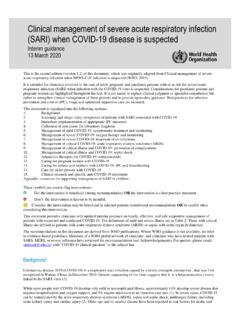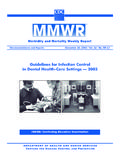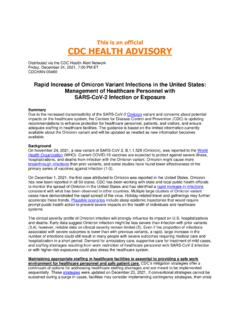Transcription of Latent tuberculosis infection - World Health Organization
1 Latent tuberculosis infection Updated and consolidated guidelines for programmatic managementLatent tuberculosis infection Updated and consolidated guidelines for programmatic managementLatent tuberculosis infection : updated and consolidated guidelines for programmatic managementISBN 978-92-4-155023-9 World Health Organization 2018 Some rights reserved. This work is available under the Creative Commons Attribution-NonCommercial-ShareAlike IGO licence (CC BY-NC-SA IGO; ). Under the terms of this licence, you may copy, redistribute and adapt the work for non-commercial purposes, provided the work is appropriately cited, as indicated below. In any use of this work, there should be no suggestion that WHO endorses any specific Organization , products or services. The use of the WHO logo is not permitted. If you adapt the work, then you must license your work under the same or equivalent Creative Commons licence.
2 If you create a translation of this work, you should add the following disclaimer along with the suggested citation: This translation was not created by the World Health Organization (WHO). WHO is not responsible for the content or accuracy of this translation. The original English edition shall be the binding and authentic edition .Any mediation relating to disputes arising under the licence shall be conducted in accordance with the mediation rules of the World Intellectual Property citation. Latent tuberculosis infection : updated and consolidated guidelines for programmatic management . Geneva: World Health Organization ; 2018. Licence: CC BY-NC-SA (CIP) data. CIP data are available at , rights and licensing. To purchase WHO publications, see To submit requests for commercial use and queries on rights and licensing, see materials. If you wish to reuse material from this work that is attributed to a third party, such as tables, figures or images, it is your responsibility to determine whether permission is needed for that reuse and to obtain permission from the copyright holder.
3 The risk of claims resulting from infringement of any third-party-owned component in the work rests solely with the disclaimers. The designations employed and the presentation of the material in this publication do not imply the expression of any opinion whatsoever on the part of WHO concerning the legal status of any country, territory, city or area or of its authorities, or concerning the delimitation of its frontiers or boundaries. Dotted and dashed lines on maps represent approximate border lines for which there may not yet be full agreement. The mention of specific companies or of certain manufacturers products does not imply that they are endorsed or recommended by WHO in preference to others of a similar nature that are not mentioned. Errors and omissions excepted, the names of proprietary products are distinguished by initial capital reasonable precautions have been taken by WHO to verify the information contained in this publication.
4 However, the published material is being distributed without warranty of any kind, either expressed or implied. The responsibility for the interpretation and use of the material lies with the reader. In no event shall WHO be liable for damages arising from its use. WHO/CDS/ vDeclaration and management of conflicts of interest viiAbbreviations ixDefinitions xExecutive summary 11. Introduction 52. Identification of populations for testing and treatment of Latent tuberculosis infection 93. Algorithms for ruling out active tuberculosis disease 144.
5 Testing for Latent tuberculosis infection 215. Treatment options for Latent tuberculosis infection 236. Preventive treatment for contacts of patients with multidrug-resistant tuberculosis 287. Issues in implementation 308. Research priorities 329. References 34 Annex 1. GRADE profile tables for new recommendations 39 Annex 2. Evidence-to-Decision and GRADE tables (online at )Annex 3. Survey on the values and preferences for the management of Latent tuberculosis infection (online at )CONTENTSvAcknowledgementsACKNOWLEDGEMEN TSO verall coordination and writing of the guidelinesYohhei Hamada and Haileyesus Getahun coordinated the development and writing of the guidelines under the overall direction of Mario steering groupAndrei Dadu (TB and M/XDR-TB Programme, WHO Regional Office for Europe); Meg Doherty (HIV department, WHO); Dennis Falzon (Global TB Programme, WHO); Nathan Ford (HIV department, WHO); Haileyesus Getahun (Global TB Programme, WHO); Christopher Gilpin (Global TB Programme, WHO); Malgorzata Grzemska (Global TB Programme, WHO); Yohhei Hamada (Global TB Programme, WHO); Andreas Reis (Information, Evidence and Research, WHO); Wilson Were (Department of Maternal, Newborn, Child and Adolescent Health , WHO).
6 Co-chairs of the WHO Guidelines Development GroupAlberto Matteelli (University of Brescia, WHO Collaborative Centre for TB/HIV and TB Elimination, Italy) and Nandi Siegfried (independent clinical epidemiologist, South Africa) GRADE methodologist for the WHO Guidelines Development GroupNandi Siegfried (independent clinical epidemiologist, South Africa).Members of WHO Guidelines Development GroupSi Thu Aung (National TB Programme, Department of Public Health , Ministry of Health , Myanmar); Rolando Cedillos (Service of Infectology and Integrated Programme for STI/HIV/AIDS, El Salvador); Richard Chaisson (Center for TB Research, Johns Hopkins University, United States of America); Padmapriyadarsini Chandrasekaran (National Institute for Research in tuberculosis , India); Lucy Chesire (TB Advocacy Consortium, Kenya); Betina Durovni (Federal University of Rio de Janeiro, Brazil); Diana Gibb (Medical Research Council, United Kingdom of Great Britain and Northern Ireland); Stephen Graham (Centre for International Child Health , University of Melbourne, Australia); Sally Hargreaves (Imperial College London, United Kingdom); Diane Havlir (University of California, USA).
7 Nguyen van Hung (National Lung Hospital, Viet Nam); Mohammed Al Lawati (Consultant Physician, Oman); Alberto Matteelli (University of Brescia, WHO Collaborative Centre for TB/HIV and TB Elimination, Italy); Lindiwe Mvusi (National Department of Health , South Africa); Nadia Ismail Abu Sabrah (consultant TB physician and epidemiologist, Jordan); Marieke van der Werf (European Centre for Disease Prevention and Control, Sweden); Wim Vandevelde (Global TB Community Advisory Board, South Africa); Irina Vasilyeva (Ministry of Health , Russian Federation)ObserversAnand Date (Centers for Disease Control and Prevention, USA); Ya Diul Mukadi (US Agency for International Development [USAID], USA). Latent tuberculosis infection : UPDATED AND CONSOLIDATED GUIDELINES FOR PROGRAMMATIC MANAGEMENTviSystematic reviewersYalemzewed Assefa (University of Queensland, Australia); Yibeltal Assefa (University of Queensland, Australia); Ioana Diana Olaru (Borstel Research Centre, Germany); Darshini Govindasamy (South African Medical Research Council, South Africa); Yohhei Hamada (Global TB Programme, WHO), Sandra Kik (KNCV tuberculosis Foundation, Netherlands); Katharina Kranzer (London School of Hygiene and Tropical Medicine, United Kingdom); Johnny Lujan (Global TB Programme, WHO); Molebogeng Xheedha Rangaka (University College London, United Kingdom); Karl Schenkel (Global TB Programme, WHO); Solomon Woldeyohannes (University of Queensland, Australia).
8 Peer reviewers Sevim Ahmedov (USAID, USA); Taye Tolera Balcha (Armauer Hansen Research Institute, Ethiopia); Amy Bloom (USAID, USA); Anne Detjen (UNICEF); Christine Ho (Centers for Disease Control and Prevention, USA); Sundari Mase (WHO Country Office, India); Michael Kimerling (KNCV tuberculosis Foundation, Netherlands); Giovanni Battista Migliori (WHO Collaborating Centre for TB and Lung Diseases, Fondazione S. Maugeri, Italy); Zelalem Temesgen (Mayo Clinic, USA).Other contributors Liani Smit (University of Stellenbosch and Western Cape Department of Health , South Africa) provided input for the survey of values and preferences; Enrico Girardi and Monica San Schepisi (Istituto Nazionale Malattie Infettive L. Spallanzani, Italy) shared results from an updated systematic review of the cost-effectiveness of testing and treatment for Latent staff and consultants Global TB Programme: Annabel Baddeley, Ernesto Jaramillo, Avinash Kanchar, Knut L nnroth, Kefas Samson, Karin WeyerHIV department: Satvinder Singh Financial supportPreparation of these guidelines was supported financially by the US Centers for Disease Control and Prevention, USAID and the Ministry of Health of the Republic of Korea.
9 ViiDeclaration and management of conflicts of interest DECLARATION AND management OF CONFLICTS OF INTERESTAll the contributors completed a WHO declaration of interests form. All the declarations were evaluated by three members of the Steering Group for any financial conflict of interest that might warrant exclusion from membership of the Guidelines Development or Peer Review Group or from discussions during preparation of the guidelines. Intellectual conflict of interest was not considered a motive for exclusion from membership of the Guidelines Development Group, as broad expertise on Latent tuberculosis (TB) was considered a criterion for selection. In addition, the diversity and representation in the Group was considered large enough to balance and overcome any potential intellectual conflict of interest. The biographies of the GDG members were made public before the meeting, in line with WHO s policy on conflicts of interest.
10 The completed forms were reviewed at the beginning of the meeting of the Guidelines Development Group, at which time members could update their Development Group The following Guidelines Development Group members declared interests, which were judged to be in no conflict with the policy of WHO or the objectives of the meeting; none of the members declared commercial financial interests that were directly or indirectly related to the objectives of the meeting. Padmapriyadarsini Chandrasekaran declared that her employer received research grants for the Model DOTS Project from USAID. Diana Gibb declared that she was coordinating a trial centre for the TB CHAMP trial, which is funded by the Medical Research Council, the Department for International Development and the Wellcome Trust. Stephen Graham declared that he had received remuneration from the Challenge TB for providing technical assistance in training and implementation of child contact screening and preventive therapy in Viet Nam between 2012 and 2016.












